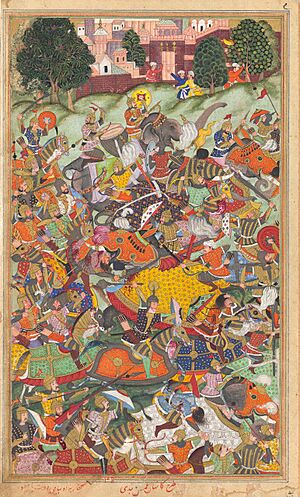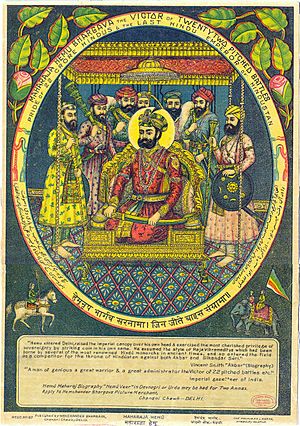Second Battle of Panipat facts for kids
Quick facts for kids Second Battle Of Panipat |
|||||||
|---|---|---|---|---|---|---|---|
 The defeat of Hemu, a c. 1590s painting by Kankar of the Second Battle of Panipat taken from the Akbarnama. |
|||||||
|
|||||||
| Belligerents | |||||||
| Sur Empire | |||||||
| Commanders and leaders | |||||||
|
|||||||
| Strength | |||||||
| 10,000 cavalry 200 war elephants |
30,000 cavalry 500 war elephants |
||||||
| Casualties and losses | |||||||
| Unknown | 5,000 | ||||||
The Second Battle of Panipat was a very important fight in Indian history. It happened on November 5, 1556. The battle was between the young Mughal emperor Akbar and a powerful king named Hemu. Hemu had recently taken control of Delhi and Agra.
Akbar and his guardian, Bairam Khan, wanted to get these lands back. So, they marched their army to meet Hemu's forces. The two armies met at Panipat, which was also the site of another big battle in 1526. During the fight, Hemu was badly hurt by an arrow and fell unconscious. When his soldiers saw their leader fall, they became scared and ran away. Hemu was captured and later died. This battle was a huge victory for the Mughals.
Contents
Why the Battle Happened
To understand why this battle happened, we need to look back a bit. The first Mughal emperor, Babur, had a son named Humayun. Humayun lost his kingdom to a strong ruler named Sher Shah Suri in 1540. Sher Shah Suri started the Sur Empire.
Delhi and Agra fell to Sher Shah. But he died in 1545. His son, Islam Shah Suri, took over and was a good ruler. However, when Islam Shah died in 1554, the Sur Empire faced many problems. There were fights over who would be the next ruler. Also, different parts of the empire started to rebel.
Humayun saw this as a chance to get his lands back. In 1555, the Mughals defeated Sikandar Shah Suri. They took back control of Delhi and Agra.
Hemu's Rise to Power
Islam Shah's young son, Firoz Khan, was supposed to be the next ruler. But his uncle killed him and took the throne. This new ruler was named Adil Shah Suri. He was more interested in having fun than ruling. So, he let a man named Hemu handle most of the state's business.
Hemu was a very smart and brave Hindu leader. He started from a simple background and became Adil Shah's chief minister and army general. When Humayun died in January 1556, Hemu saw a great chance. He decided to attack the Mughals and take back the lost territories.
Hemu quickly marched his army from Bengal. He drove the Mughals out of many cities. When he reached Agra, the Mughal governor ran away without a fight. Hemu then went to Tughlaqabad, near Delhi. There, he fought and defeated the Mughal governor of Delhi, Tardi Beg Khan. Hemu took control of Delhi on October 7, 1556. He then declared himself king and took the title of Vikramaditya.
Getting Ready for Battle
When the 13-year-old Akbar and his guardian Bairam Khan heard about Hemu taking Delhi, they immediately set off. They wanted to reclaim their capital.
A Lucky Break for the Mughals
Something lucky happened for the Mughals. A Mughal general named Ali Quli Khan Shaibani was sent ahead with 10,000 horsemen. He came across Hemu's artillery (big guns) being moved with very few guards. Ali Quli Khan easily captured all of Hemu's cannons. The Afghan guards ran away without fighting. This was a huge loss for Hemu, as he would not have any cannons in the main battle.
On November 5, 1556, the Mughal army met Hemu's army at Panipat. Akbar and Bairam Khan stayed a bit behind the main battle.
How the Armies Lined Up
Mughal Army Setup
The Mughal army was led by Ali Quli Khan Shaibani. He had 10,000 horsemen in the middle. Sikandar Khan Uzbak was on the right side, and Abdulla Khan Uzbak was on the left. The front part of the army was led by Husain Quli Beg and Shah Quli Mahram. This group also included some special soldiers from Bairam Khan.
Hemu's Army Setup
Hemu's army was much bigger. He had 30,000 horsemen, who were Afghan soldiers. He also had 500 war elephants. Each elephant was covered in armor and had soldiers on its back. These soldiers used muskets and crossbows. Hemu himself led his army from atop a famous elephant named Hawai.
Hemu's army was very experienced and confident. Hemu had already won 22 battles before this one. However, he had no artillery because the Mughals had captured it.
The Battle Unfolds
Hemu started the attack. He sent his powerful elephants charging into the Mughal army's right and left sides. The Mughal soldiers who managed to escape the elephants did not run away. Instead, they moved to the sides and attacked Hemu's horsemen. They used their excellent archery skills to shoot arrows at the enemy.
The Mughal center also moved forward. They took a strong position behind a deep ditch. Hemu's elephants and horsemen could not cross this ditch to reach the Mughals. This made them easy targets for the Mughal archers. Meanwhile, the fast Mughal horsemen attacked the Afghan army from the sides and the back. They aimed for the elephants' legs or tried to take down their riders. Hemu had to pull his elephants back, and the Afghan attack slowed down.
Hemu's Injury and the Turning Point
Seeing the Afghan attack weaken, Ali Quli Khan led his horsemen out. They rode around and attacked the center of Hemu's army from behind. Hemu was watching the battle from his seat on Hawai. He quickly moved to stop this attack. Even after seeing two of his important leaders, Shadi Khan Kakkar and Bhagwan Das, fall, Hemu kept fighting. He led counterattacks against the Mughals, using his elephants to charge at anyone who challenged him.
It was a very close battle, and it seemed like Hemu might win. Both sides of the Mughal army had been pushed back. Hemu moved his elephants and horsemen forward to crush the Mughal center. But at this critical moment, Hemu was hit in the eye by a random Mughal arrow. He fell unconscious.
When Hemu's army saw him fall, they panicked. They broke their formation and ran away. The battle was lost for Hemu. About 5,000 of his soldiers died on the battlefield, and many more were killed while trying to escape.
What Happened After the Battle
The elephant carrying the unconscious Hemu was captured after the battle. It was led to the Mughal camp. Bairam Khan asked the 13-year-old Akbar to kill Hemu. Some stories say Akbar refused. However, other historical writings say Akbar did follow Bairam Khan's advice and killed Hemu. After this, Akbar took the title of Ghazi, which means a warrior for faith.
After Hemu's death, Adil Shah's luck also ran out. He was defeated and killed in April 1557. The Mughals gained a lot from the battle at Panipat. They captured 120 of Hemu's war elephants. These powerful animals impressed the Mughals so much that they became a very important part of their army's plans.
See also


